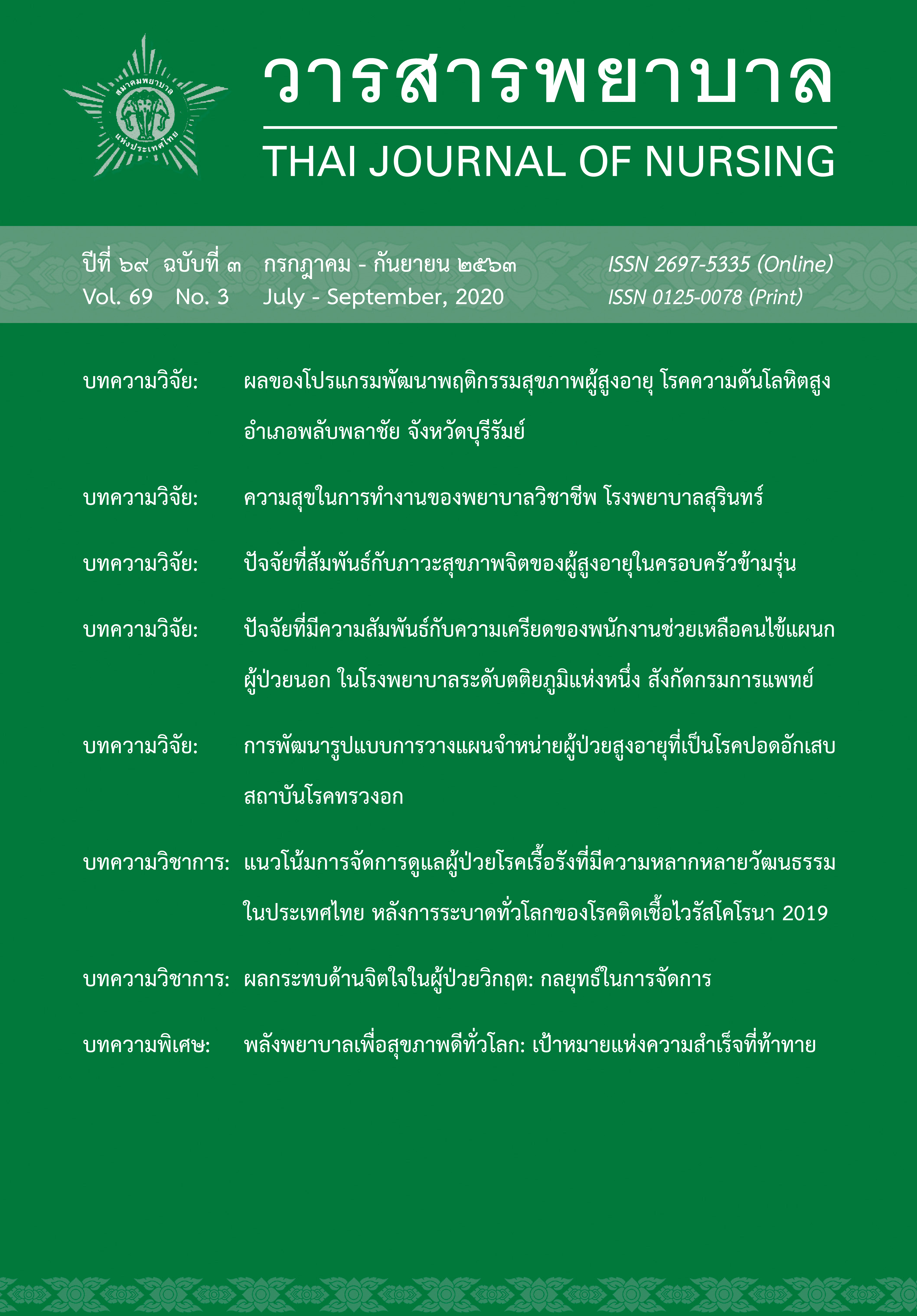The development of a discharge planning model for elderly patients with Pneumonia at Central Chest Institute of Thailand
Main Article Content
Abstract
The purposes of this research and development were: 1) to study problem situations of discharge planning model for elderly patients with pneumonia at Central Chest Institute of Thailand, 2) to develop a discharge planning model for elderly patients with pneumonia and 3) to compare caregivers’ perception on self-efficacy and satisfaction toward the discharge planning model before and after developing the model. The samples whom were purposive sampling were: 1) nine professional nurses, 2) seventy six caregivers of elderly patients with pneumonia. The research tools were as follows. Questionnaires on caregivers’ perception of self-efficacy and satisfaction toward the discharge planning model, and the discharge planning model. The reliability coefficient of the questionnaires was 0.96. Data were analyzed by descriptive statistics and t-test. The research findings were as follows. 1) Problem situations of the discharge planning model for elderly patients with pneumonia revealed into 3 aspects including (1) Structure: the hospital had a discharge planning policy and unclear guidelines, caregivers’ non-participation and shortage of related tools, (2) Process: lack of systematic procedures and recording. (3) Outcome: there was no comprehensive evaluation. 2) The developed discharge planning model embraces systematic steps; patients and caregivers assessment, diagnosis, planning with nurses, patients and caregivers participation, implementation, evaluation using the D-METHOD and empowerment along with discharge planning records. 3) The mean score of perception on self-efficacy and satisfaction toward the discharge planning model of caregivers after developing the model were significantly higher than before development at p < .05.
Article Details
References
กระทรวงสาธารณสุข กรมควบคุมโรค, สำนักงานระบาดวิทยา. (2561). สรุปรายงานการเฝ้าระวังโรคทางระบาด
วิทยา ประจำปี 2561. นนทบุรี: ผู้แต่ง.
กำธร มาลาธรรม. (2550). โรคติดเชื้อในผู้สูงอายุ. รามาธิบดีพยาบาลสาร, 13(3), 272-287.
ชไมพร บัวพิน. (2562). ประสิทธิผลของแนวปฏิบัติทางการพยาบาลการวางแผนจำหน่ายต่อคุณภาพชีวิตของ
ผู้ป่วยสูงอายุโรคหลอดเลือดสมอง. วารสารเครือข่ายวิทยาลัยพยาบาลและการสาธารณสุขภาคใต้, 6(1),
- 62.
นวลตา โพธิ์สว่าง. (2557). การพัฒนารูปแบบการวางแผนจำหน่ายผู้ป่วยโรคปอดอุดกั้นเรื้อรัง. วารสารการ
พยาบาลและการดูแลสุขภาพ, 32(1), 165-175.
บุญใจ ศรีสถิตย์นรากูร. (2553). ระเบียบวิธีการวิจัยทางพยาบาลศาสตร์ (พิมพ์ครั้งที่ 5). กรุงเทพมหานคร:
ยูแอนไออินเตอร์มีเดีย.
ประคอง กรรณสูต. (2542). สถิติเพื่อการวิจัยทางพฤติกรรมศาสตร์(พิมพ์ครั้งที่ 3). กรุงเทพมหานคร:
สำนักพิมพ์แห่งจุฬาลงกรณ์มหาวิทยาลัย.
เพ็ญจันทร์ แสนประสาน. (2560). การวางแผนจําหน่ายผู้ป่วยที่ได้รับการรักษาโรคหลอดเลือดโคโรนารีย์
ผ่านสายสวน: มุมมองของผู้ป่วยสูงอายุโรคหัวใจขาดเลือดและญาติผู้ดูแล. วารสารพยาบาลโรคหัวใจ
และทรวงอก, 28(1), 142-153.
เรวดี ศรีสุข. (2558). ผลของโปรแกรมการวางแผนจำหน่ายต่อพฤติกรรมการดูแลตนเองและภาวะสุขภาพ
ของผู้ป่วยสูงอายุที่มีภาวะหัวใจล้มเหลวที่เข้ารับการรักษาในโรงพยาบาลศูนย์เขตภาคกลาง.
วารสารวิทยาลัยพยาบาลบรมราชชนนี อุตรดิตถ์, 7(1), 13-30.
วันเพ็ญ พิชิตพรชัย, และอุษาวดี อัศดรวิเศษ. (2546). การวางแผนจำหน่ายผู้ป่วยแนวคิดและการประยุกต์
ใช้ (ฉบับปรับปรุง). กรุงเทพมหานคร: คณะพยาบาลศาสตร์ มหาวิทยาลัยมหิดล.
สถาบันโรคทรวงอก, งานเวชระเบียนและสถิติ. (2562). สถิติผู้ป่วยที่มารับบริการปี 2561. นนทบุรี:
ผู้แต่ง.
สถาบันรับรองคุณภาพสถานพยาบาล (องค์กรมหาชน). (2561). มาตรฐานโรงพยาบาลและบริการสุขภาพ
ฉบับที่ 4. กรุงเทพมหานคร: หนังสือวันดี.
สุรีย์ ธรรมิกบวร. (2554). การพยาบาลองค์รวม: กรณีศึกษา. กรุงเทพมหานคร: ธนาเพรส.
โสพิศ สุมานิต. (2554). ผลของการเสริมสร้างการรับรู้สมรรถนะแห่งตนต่อการรับรู้สมรรถนะการมีส่วนร่วมดูแลผู้ป่วยเด็ก
ภาวะวิกฤตของผู้ดูแล. รามาธิบดีพยาบาลสาร, 17(1), 66-74.
Aday, L A., & Andersen, R. (1975). Development of indices of access to medical care. Ann Arbor, MI:
Health Administration Press.
Bandura, A. (1986). Social foundations of thought and action. New York: Prentice Hall.
Chen, G., Gully, S. M., & Eden, D. (2001). Validation of a new general self-efficacy scale.
Organizational Research Methods, 4(1), 62-83. doi: 10.1177/109442810141004
Kanter, R. M. (1993). Men and women of the corporation. New York: Basic Books.
Lin, C. (2012). Discharge planning. International Journal of Gerontology, 6(4), 237-240.
Mckeehan, E. M. (1981). Continuing care: A multidisciplinary approach to discharge
planning. St. Louis: The C.V.Mosby.
Wong, E. L., Yam,C. H., Cheung, A. W., Leung, M. C., Chan, F. W., Wong, F. Y., & Yeoh, E.
K. (2011). Barriers to effective discharge planning: A qualitative study investigating the
perspectives of frontline healthcare professionals. BMC Health Services Research, 11(1), 242.
doi: 10.1186/1472-6963-11-242

